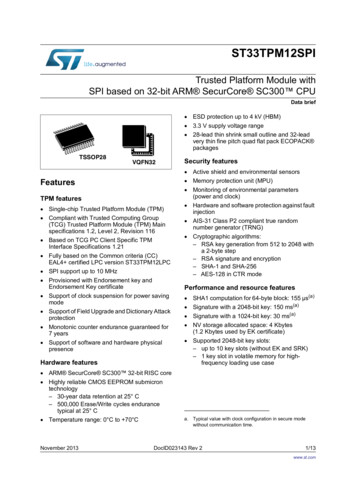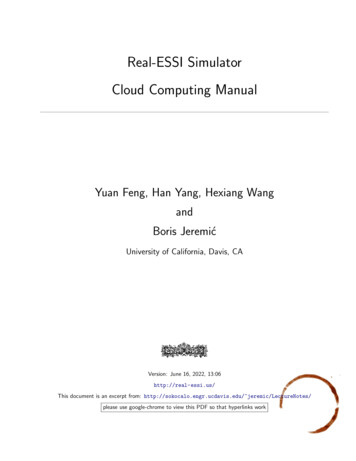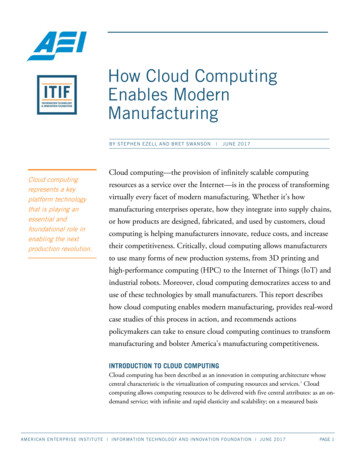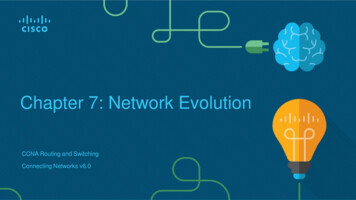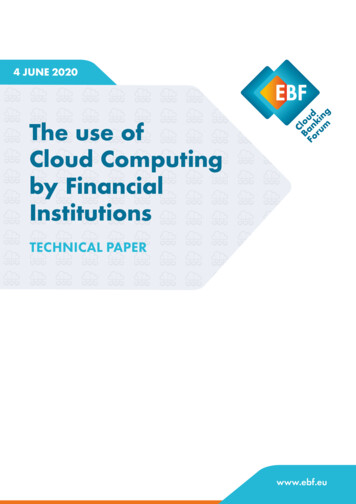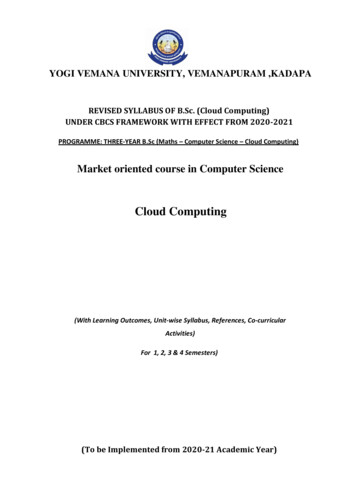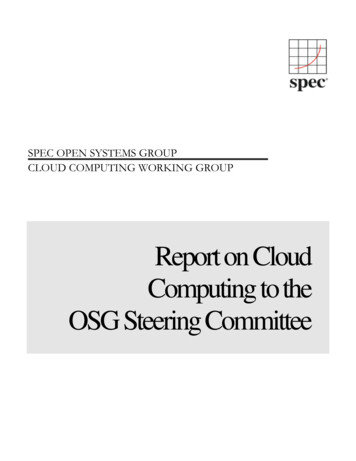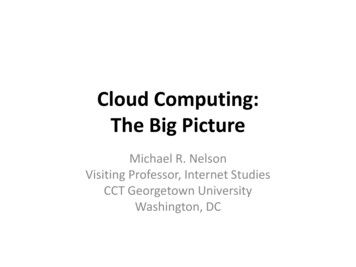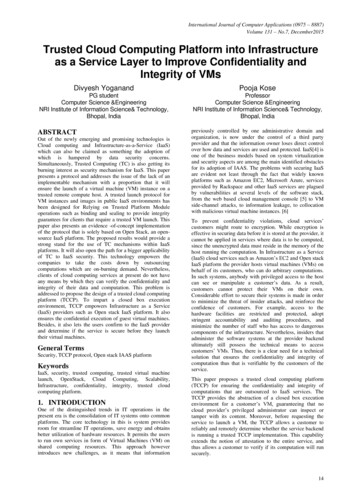
Transcription
International Journal of Computer Applications (0975 – 8887)Volume 131 – No.7, December2015Trusted Cloud Computing Platform into Infrastructureas a Service Layer to Improve Confidentiality andIntegrity of VMsDivyesh YoganandPooja KosePG studentComputer Science &EngineeringNRI Institute of Information Science& Technology,Bhopal, IndiaProfessorComputer Science &EngineeringNRI Institute of Information Science& Technology,Bhopal, IndiaABSTRACTpreviously controlled by one administrative domain andorganization, is now under the control of a third partyprovider and that the information owner loses direct controlover how data and services are used and protected. IaaS[4] isone of the business models based on system virtualizationand security aspects are among the main identified obstaclesfor its adoption of IAAS. The problems with securing IaaSare evident not least through the fact that widely knownplatforms such as Amazon EC2, Microsoft Azure, servicesprovided by Rackspace and other IaaS services are plaguedby vulnerabilities at several levels of the software stack,from the web based cloud management console [5] to VMside-channel attacks, to information leakage, to collocationwith malicious virtual machine instances. [6]Out of the newly emerging and promising technologies isCloud computing and Infrastructure-as-a-Service (IaaS)which can also be claimed as something the adoption ofwhich is hampered by data security concerns.Simultaneously, Trusted Computing (TC) is also getting itsburning interest as security mechanism for IaaS. This paperpresents a protocol and addresses the issue of the lack of animplementable mechanism with a proportion that it willensure the launch of a virtual machine (VM) instance on atrusted remote compute host. A trusted launch protocol forVM instances and images in public IaaS environments hasbeen designed for Relying on Trusted Platform Moduleoperations such as binding and sealing to provide integrityguarantees for clients that require a trusted VM launch. Thispaper also presents an evidence -of-concept implementationof the protocol that is solely based on Open Stack, an opensource IaaS platform. The proposed results would provide astrong stand for the use of TC mechanisms within IaaSplatforms. It will also open the path for a bigger applicabilityof TC to IaaS security. This technology empowers thecompanies to take the costs down by outsourcingcomputations which are on-burning demand. Nevertheless,clients of cloud computing services at present do not haveany means by which they can verify the confidentiality andintegrity of their data and computation. This problem isaddressed to propose the design of a trusted cloud computingplatform (TCCP). To impart a closed box executionenvironment, TCCP empowers Infrastructure as a Service(IaaS) providers such as Open stack IaaS platform. It alsoensures the confidential execution of guest virtual machines.Besides, it also lets the users confirm to the IaaS providerand determine if the service is secure before they launchtheir virtual machines.General TermsSecurity, TCCP protocol, Open stack IAAS platformKeywordsIaaS, security, trusted computing, trusted virtual machinelaunch, OpenStack, Cloud Computing, Scalability,Infrastructure, confidentiality, integrity, trusted cloudcomputing platform.1. INTRODUCTIONOne of the distinguished trends in IT operations in thepresent era is the consolidation of IT systems onto commonplatforms. The core technology in this is system providesroom for streamline IT operations, save energy and obtainsbetter utilization of hardware resources. It permits the usersto run own services in form of Virtual Machines (VM) onshared computing resources. This approach howeverintroduces new challenges, as it means that informationTo prevent confidentiality violations, cloud services’customers might route to encryption. While encryption iseffective in securing data before it is stored at the provider, itcannot be applied in services where data is to be computed,since the unencrypted data must reside in the memory of thehost running the computation. In Infrastructure as a Service(IaaS) cloud services such as Amazon’s EC2 and Open stackIaaS platform the provider hosts virtual machines (VMs) onbehalf of its customers, who can do arbitrary computations.In such systems, anybody with privileged access to the hostcan see or manipulate a customer’s data. As a result,customers cannot protect their VMs on their own.Considerable effort to secure their systems is made in orderto minimize the threat of insider attacks, and reinforce theconfidence of customers. For example, access to thehardware facilities are restricted and protected, adoptstringent accountability and auditing procedures, andminimize the number of staff who has access to dangerouscomponents of the infrastructure. Nevertheless, insiders thatadminister the software systems at the provider backendultimately still possess the technical means to accesscustomers’ VMs. Thus, there is a clear need for a technicalsolution that ensures the confidentiality and integrity ofcomputation thus that is verifiable by the customers of theservice.This paper proposes a trusted cloud computing platform(TCCP) for ensuring the confidentiality and integrity ofcomputations that are outsourced to IaaS services. TheTCCP provides the abstraction of a closed box executionenvironment for a customer’s VM, guaranteeing that nocloud provider’s privileged administrator can inspect ortamper with its content. Moreover, before requesting theservice to launch a VM, the TCCP allows a customer toreliably and remotely determine whether the service backendis running a trusted TCCP implementation. This capabilityextends the notion of attestation to the entire service, andthus allows a customer to verify if its computation will runsecurely.14
International Journal of Computer Applications (0975 – 8887)Volume 131 – No.7, December20152. 2. BACKGROUND2.1 Infrastructure as a ServiceToday, myriads of cloud providers offer services at variouslayers of the software stack. At lower layers, Infrastructureas a Service (IaaS) providers such as Amazon, Flexiscale,and GoGrid allow their customers to have access to entirevirtual machines (VMs) hosted by the provider. A customer,and user of the system, is responsible for providing the entiresoftware stack running inside a VM. At higher layers,Software as a Service (SaaS) systems such as Google Appsoffer complete online applications than can be directlyexecuted by their users.The difficulty is in ensuring the confidentiality ofcomputations increases for services sitting on higher layersof the software pile because services themselves impart andrun the software that directly manipulates customer’s data(e.g., Google Docs). In this paper it is focused that the lowerlayer IaaS cloud providers where securing a customer’s VMis more manageable.Figure 1: Simplified Architecture of IaaS2.2 Trust and attack modelsIn present IaaS providers, it can be reasonably consideredthat no single person accumulates all these privileges.Moreover, providers already happen to arrange stringentsecurity devices, restricted access control policies, andsurveillance mechanisms to protect the physical integrity ofthe hardware. In this way, researcher presumes that, byenforcing a security perimeter, the provider itself can preventattacks that require physical access to the machines. Though,sysadmins require privileged permissions at the cluster’smachines to manage the software they run. Since we do notexactly know the praxis of current IaaS providers, weassume in their attack model that sysadmins can loginremotely to any machine with root privileges, at any point intime. The only way a sysadmin would be able to gainphysical access to a node running a costumer’s VM is bydiverting this VM to a machine under her control, locatedoutside the IaaS’s security perimeter. Therefore, the TCCPmust be able to 1) confine the VM execution inside theperimeter, and 2) guarantee that at any point a sysadmin withroot privileges remotely logged to a machine hosting a VMcannot access its memory.Researcher shares the attack model with [11,12,13] whichconsiders that privileged access right scan be maliciouslyused by remote system administrators (Ar) of theIaaSprovider. In current IaaS providers, it can be reasonablyconsidered that no single person accumulates all theseprivileges. Moreover, providers already organize stringentsecurity devices, restricted access control policies, andsurveillance mechanisms to protect the physical integrity ofthe hardware. Thus, researcher assumes that, by enforcing asecurity perimeter, the provider itself can prevent attacks thatrequire physical access to the machines.2.3 Trusted ComputingThe Trusted Computing Group (TCG) [10] proposed a set ofhardware and software technologies to enable theconstruction of trusted platforms. In particular, the TCGproposed a standard for the design of the trusted platformmodule (TPM) chip that is now bundled with commodityhardware. The TPM holds an endorsement private key (EK)that can distinctively identify the TPM (thus, the physicalhost), and some cryptographic functions which can never bemodified. The respective manufacturers sign thecorresponding public key to guarantee the correctness andvalidity of the key.Trusted platforms [7, 8, 9, 10] leverage the features of TPMchips to enable remote attestation. This mechanism works asfollows. At boot time, the host computes a measurement listML consisting of a sequence of hashes of the softwareinvolved in the boot sequence, namely the BIOS, the bootloader, and the software implementing the platform. The MLis securely stored inside the host’s TPM. To confirm to theplatform, a remote party challenges the platform running atthe host with a nonce nU. The local TPM is asked to create amessage containing both the ML and the nU, encrypted withthe TPM’s private EK. The host sends the message back tothe remote party who can decrypt it using the EK’scorresponding public key, thereby authenticating the host.By checking that the nonces match and the ML correspondsto a configuration it deems trusted, a remote party canreliably identify the platform on an untrusted host. A trustedplatform like Terra implements a thin VMM that enforces aclosed box execution environment, meaningthat a guest VMrunning on top cannot be examined or modified by a userwith full privileges over the host. The VMM assures itsintegrity till the machine does not reboot. Thus, a remoteparty can attest to the platform running at the host to verifythat a trusted VMM implementation is running, and thusmake it sure that her computation running in a guest VM issecured. Given that a traditional trusted platform can securethe computation on a single host, a natural approach tosecure an IaaS service would be to deploy the platform ateach node of the service’s backend (see Figure 1).Figure 2: The components of the trustedclocomputingPlatform include a set of trusted nodes (N)and the trusted coordinator (TC). The entrusted cloudmanager(CM) makes a set of services available to users.The TCis maintained by an external trusted entity(ETE).3. TRUSTED CLOUD COMPUTINGPLATFORMResearcher launch the trusted cloud computing platform(TCCP) that provides a closed box execution environment byextending the concept of trusted platform to an entire IaaSbackend. The TCCP guarantees the confidentiality and the15
International Journal of Computer Applications (0975 – 8887)Volume 131 – No.7, December2015integrity of a user’s VM, and allows a user to determine upfront whether or not the IaaS enforces these properties.byindependent companies analogous to today’s certificateauthorities like VeriSign.3.1 Overview3.2 Detailed DesignTCCP enhances today’s IaaS backends to enable closed boxsemantics without substantially changing the architecture(Figure 2). The trusted computing base of the TCCP includestwo components: a trusted virtual machine monitor(TVMM), and a trusted coordinator (TC).In this section, researcher provides the details the mostrelevant TCCP mechanisms. Researcher narrate theprotocols that manage the set of nodes of the platform thatare trusted (Section 3.2.1), and the protocols that secure theoperations involving VM management, namely launchingand migrating VMs (Section 3.2.2). In these protocols, thefollowing notation for cryptographic operations is used. Thepair hKp, KP it represents the private-public keys of anasymmetric cryptography key pair. Notation {y}Kx indicatesthat data y is encrypted with key Kx. Researcher use aspecific notation for the following keys: EKx denoteendorsement keys, TKx indicate trusted keys, and Kx denotesession keys. Nonces nx, unique numbers generated by x,help detect message replays.Figure 3: Message exchange during node registration.Each node of the backend runs a TVMM that hostscustomers’ VMs, and prevents privileged users frominspecting or modifying them. Over time, the integrity ofTVMM is protected by it and complies with the TCCPprotocols. Nodes embed a certified TPM chip and must gothrough a secure boot process to install the TVMM. Due tospace limitations researcher need not go into detail about thedesign of the TVMM, and researcher refer the reader to [14]for an architecture that can be leveraged and followed tobuild a TVMM that enforces local closed box protectionagainst a malicious sysadmin.1. nN3.2.1Node managementThe TC dynamically operates the set of trusted nodes thatcan host a VM by maintaining a directory containing, foreach node within the security perimeter, the publicendorsement key EKP N identifying the node’s TPM, andthe expected measurement list MLN. The ETE makes someproperties of the TC securely available to the public, namelythe EKP TC, the MLTC, and the TKP TC (identifying theTC). The canonical configurations are expressed by both theMLN and the MLTC that a remote party is expected toobserve when attesting to the platform running on a node Nor on the TC, respectively.2. MLTC , nN EK PTC , nTC3. MLN , nTC EK PN , TK PN4. acceptedTK PTCTK PNThe TC manages the set of nodes that can run a customer’sVM securely. It is called trusted nodes. To be trusted, a nodemust be located within the security perimeter, and run theTVMM. To meet these conditions, the TC maintains a recordof the nodes located in the security perimeter, and attests tothe node’s platform to verify that the node is running atrusted TVMM implementation. It is said that the TC cancope with the occurrence of events such as adding orremoving nodes from a cluster, or shutting down nodestemporarily for maintenance or upgrades. A user can verifywhether the IaaS service secures its computation by attestingto the TC.To secure the VMs, each TVMM running at each nodecooperates with the TC in order to 1) confine the executionof a VM to a trusted node, and to 2) protect the VM stateagainst inspection or modification when it is in transit on thenetwork. The critical moments that require such protectionsare the operations to launch, and migrate VMs. Researcherhypothesize that an external trusted entity (ETE) that hoststhe TC, and securely updates the information provided to theTC about the set of nodes deployed within the IaaS perimeteramong others. Above all, sysadmins that manage the IaaShave no privileges inside the ETE, and therefore cannottamper with the TC. Researcher envisions that the ETEshould bemaintained by a third party with little or noincentive to collude with the IaaS provider e.g.,Figure 4: Message exchange during VM launch1. α, #α K VM nU , K VM2.nU , K VMTK PTC , nN3. nN , nU , K VM4. nU , NTK PNTK PTCTK PN,NTK PTCTK PTCK VMIn order to be trusted, a lump must register with the TC bycomplying with the protocol depicted on Figure 3. In steps 1and 2, N attests to the TC to avoid an impersonation of theTC by an attacker: N sends a challenge nN to the TC, and theTC replies with its bootstrap measurements MLTCencrypted with EKp TC to guarantee the authenticity of theTC. If the MTC matches the expected configuration, itmeans the TC is trusted. Reversely, the TC also attests to Nby piggybacking a challenge nTC in message 2, andchecking whether the node is authentic, and is running theexpected configuration (step 3). The node generates a keypair hTKpN, TKPN and sends its public key to the TC. If16
International Journal of Computer Applications (0975 – 8887)Volume 131 – No.7, December2015both peers mutually attest successfully, the TC adds TKPNto its node database, and sends message 4 to confirm that thenode is trusted. Key TKN ensures that node N is trusted. Atrusted node reboots, theTCCP must assure that the node’sconfiguration remains trusted; or the node could compromisethe security of the TCCP. To ensure this, the node onlykeepsTKp N inmemory causing the key to be lost once themachine reboots. The node is thus banned from the TCCP,since it will not be able to decrypt messages encrypted withthe previous key, and must repeat the registrationprotocol.The first purpose of TCCP is to ensure theconfidentiality and integrity of cloud consumer’scomputations. it is based on trusted open stack is used intheir prototype implementation. Per 5 minutes analysis andstatistics are shown in figure 5.Figure 5: TCCP Protocol Statistics3.2.2Virtual machine managementResearcher represent the TCCP protocols to secure the VMlaunch and migration operations. When launching a VM, theTCCP needs to guarantee that 1) the VM is launched on atrusted node, and 2) the sysadmin is unable to inspect ortamper with the initial VMstate as it traverses thepathbetween the user and the node hosting the VM. Theinitial VM state contains the VM image (VMI) (that can bepersonalized and contain secret data) and the user’s publickey (used for ssh login) 1. In practice, the user can decide touse a VMI provided by the IaaS.To implement these requirements, the parties involved inlaunching a VM follows the protocol depicted in Figure4.This protocol has been designed on the fact that, beforelaunching the VM, a user does not know which physicalnode the VM will be assigned, and, among the componentsofthe service, only trusts the TC. First, the user generates asession key KVM, and sends message 1 to the CMcontaining: α and α’s hash encrypted with the session key (toprotect the confidentiality and integrity of the initial state),and KVM encrypted with TKP TC. Encrypting the sessionkey with the TC’s public key ensures that only the TC canauthorize someone to access α. The TC only authorizestrusted nodes.After receiving the request to launch a VM, the CMdesignates a node N from the cluster to host the VM, andforwards the request to N. Since the node needs to access αin order to boot the VM, it sends message 2 to TC whichdecrypts KVM on N’s behalf. This message is encryptedwith TKp N so that the TC can verify whether N is trusted. Ifthe corresponding public key is not found in the TC’s trustednode database, the request is denied. This would have beenthe case had the CM diverted the request to a node controlledby a malicious sysadmin. Otherwise, the node is reckoned tobe trusted; the TC decrypts the session key, and sends it tothe node in message 3, such that only N can read the key. Nis now able to decrypt α, and boot the VM. Finally, message4 is sent by the node to the user containing the identity of thenode running the VM.Nd. To secure this operation, both nodes must be trusted, andthe VM state must remain confidential and unmodified whileit is in transit over the network. Figure 4 shows the sequenceof messages involved in securing the migration of a VM. Insteps 1 and 2, Ns asksTC to check whether Nd is trusted. Inmessage 3, Ns negotiates a session key KS with Nd that willbe used to secure the transfer of the VM state.Beforeaccepting the key, Nd first verifies that Ns is trusted (steps 4and 5). If both nodes mutually authenticate successfully, Ndacknowledges the acceptance of the session key to the KS(step 6), and, in message 7, Ns finally transfers the encryptedand hashed VM state to the Nd, guaranteeing theconfidentiality and integrity of the VM.4. PROTOCOL IMPLEMENTATION4.1 Open stack IaaS platformThe Essex release of OpenStack comprises ve corecomponents (projects), namely Compute (Nova), ImageService (Glance), Object Storage (Swift), Identity Service(Keystone) and Dashboard (Horizon). Nova has several subcomponents: nova-api, nova-compute, nova-schedule, novanetwork, nova-volume, plus an SQL database and messagequeue functionality to pass messages between subcomponents. OpenStack components affected by theprotocol implementation are mentioned here in more detail:-Nova-api is the interface for nova- compute and volumeAPI calls. It is through this interface most of the cloudorchestration operations are performed. The interfacesupports both the OpenStack and Amazon EC2 APIs.-Nova-compute handles virtual machine instance life cycletasks through hypervisor API calls. Notably the libvirt andXenAPI hypervisor APIs are supported.-Nova-schedule is responsible for selecting compute host(s)to run virtual machine instances on. The host selectionprocess is determined by which scheduling policy/algorithmis employed.-The nova SQL database holds tables and relations todescribe the state of nova, such as launched instances andnetwork configurations.-The Dashboard is a web based GUI for OpenStackoperation and administration. It interfaces nova-api.5. CONCLUSIONS AND FUTUREWORKThus it is argued that concerns about the confidentiality andintegrity of their data and computation are a major deterrentfor enterprises looking to embrace cloud computing. It ispresented in this design of a trusted cloud computingplatform (TCCP) that enables IaaS services such as AmazonEC2 to provide a closed box execution environment. TCCPassures confidential execution of guest VMs, and allowsusers to attest to the IaaS provider and determine if theservice is secure before they launch their VMs. It is plannedto implement a fully functional prototype based on theirdesign and evaluate its performance in the near future.Moreover, researcher has provided a prototypeimplementation of the launch protocol in Open Stack. Thegiven results make a case for broadening the range and alsolimits of use cases for trusted computing by applying it toIaaS environments, in particular within the security model ofan entrusted IaaS provider.In live migration [3], the state of an executing VM istransferred between two nodes: a source Ns anda destination17
International Journal of Computer Applications (0975 – 8887)Volume 131 – No.7, December20156. REFERENCES[1] Nicolae Paladi1, Christian Gehrmann1, MudassarAslam1, and Fredric Morenius2. “Trusted Launch ofVirtual Machine Instances in Public IaaSEnvironments” October 2011, AFCEA cybercommunit.[2] Nicolae Paladi1, Christian Gehrmann1, MudassarAslam1, and Fredric Morenius2. “Trusted Launch ofVirtual Machine Image in Public IaaS Environments”October 2011, AFCEA cyber communit.[3] Nuno Santos, Krishna P. Gummadi, Rodrigo Rodrigues:Towards Trusted Cloud Computing (MPI-SWS)[4] Aryan Taherimonfared Securing IaaS services model ofcloud computing against compromised components2011.[5] Somorovsky,J Heiderich,M., Jensen,M., Schwenk, J.,Gruschka,N., LoIacono, L.: All Your Clouds AreBelong to us: Security Analysis of Cloud ManagementInterfaces.In: Proceedings of the 3rd ACM ,NY,USA,ACM(2011) 3–14[6] Ristenpart, T., Tromer, E., Shacham, H., Savage, S.:Hey, You, Get Off of My Cloud: ExploringInformation Leakage in Third-Party Compute Clouds.In: Proceedings of the 16th ACM ConferenceonComputer and Communications Security. CCS ’09,New York, NY, USA, ACM (2009) 199–212[7] S. Berger, R. C aceres, K. A. Goldman, R. Perez, R.Sailer, and L. van Doorn. vTPM: virtualizing the trustedplatform module. In Proc. of USENIX-SS’06, Berkeley,CA, USA, 2006.[8] Survey: Cloud Computing ’No Hype’, But Fear cleid.com/posts/20090226 cloud computing hype security/.[9] C. Clark, K. Fraser, S. Hand, J. G. Hansen, E. Jul, C.Limpach, I. Pratt, and A. Warfield. Live migration ofvirtual machines. In Proc. of NSDI’05, pages 273–286,Berkeley, CA, USA, 2005.USENIX Association.[10] CloudComputing.In:Proceedingsofthe2009Conference onHot Topics inCloudIJCATM : ,CA,USA,USENIXAssociation(2009)[11] rely LaunchingVirtual Machines �sPerspective. In Leymann,F., Ivanov, I., 1[12] Aslam,M.,Gehrmann,C.,Bjorkman,M.:SecurityandTrust Preserving VM Migration sin Public Clouds.In:2012IEEE 11thInternationalConference on s(TrustCom), TRUSTCOM,Liverpool(2012)[13] T. Garfinkel, B. Pfaff, J. Chow, M. Rosenblum, and D.Boneh. Terra: A Virtual Machine-Based Platform forTrusted Computing. In Proc. of SOSP’03, 2003D. G.Murray, G. Milos, and S. Hand. Improving Xen securitythrough disaggregation. In Proc. of VEE’08, pages 151–160, NewYork, NY, USA, 2008.[14] D. Nurmi, R. Wolski, C. Grzegorczyk, G. Obertelli, S.Soman,L. Youseff, and D. Zagorodnov. Eucalyptus: ATechnical Report on an Elastic Utility ComputingArchitecture Linking Your Programs to UsefulSystems. Technical Report 2008-10, UCSBComputerScience, 2008.[15] B. D. Payne, M. Carbone, and W. Lee. Secure andFlexible Monitoring of Virtual Machines. In Proc. ofACSAC’07, 2007.[16] T. R. Peltier, J. Peltier, and J. Blackley. InformationSecurity Fundamentals. Auerbach Publications, Boston,MA, USA, 2003.[17] R. Sailer, T. Jaeger, E. Valdez, R. Caceres, R. Perez, S.Berger, J. L. Griffin, and L. v. Doorn. Building a MACBased Security Architecture for the Xen Open-SourceHypervisor. In Proc. Of ACSAC ’05, Washington, DC,USA, 2005[18] Smith, J., Nair, R.: Virtual Machines: fmann(June2005)[19] Krutz,R.L.,Vines,R.D.:CloudSecurity:AComprehensive Guide to Secure Cloud Computing.John Wiley &Sons(August2010)18
(IaaS) providers such as Open stack IaaS platform. It also ensures the confidential execution of guest virtual machines. Besides, it also lets the users confirm to the IaaS provider and determine if the service is secure before they launch their virtual machines. General Terms Security, TCCP protocol, Open stack IAAS platform Keywords



